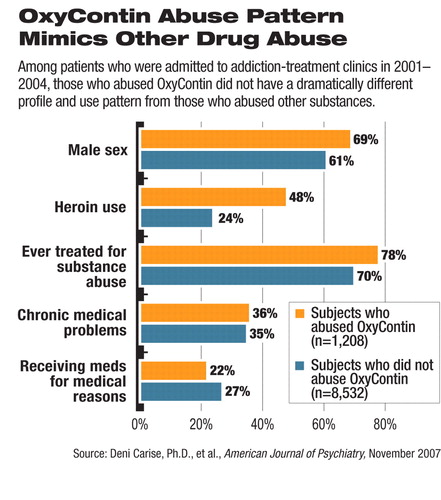Most OxyContin Users Abuse Other Drugs
Despite much media hype in the past decade, people who abuse OxyContin are generally not different from those with other types of addiction, and very few of them are “drug-naïve” and got “hooked” on OxyContin after legitimate prescriptions of the drug for pain management, a study published in the November American Journal of Psychiatry has found.
The authors, led by Deni Carise, Ph.D., examined data from a large, nationwide database that tracks substance addiction patterns of people who seek treatment at various types of treatment programs. Among nearly 28,000 patients entering 157 treatment programs between 2001 and 2004, about 5 percent reported having ever used OxyContin, most of whom (1,243 patients) were classified as regular users (more than three times a week for at least one year) of the substance. Almost all (92 percent) of the OxyContin regular users also used other substances, especially opiates, and nearly three-quarters had received substance abuse treatment before. Most (78 percent) did not get their OxyContin from legitimate prescriptions for any medical reason.
The study authors identified specific characteristics statistically associated with regular use of OxyContin. These patients were significantly more likely to be white, male, older, and employed full time and had greater severity or acuity on the psychiatric and family aspects on intake assessments. OxyContin abuse was less likely in those who had not used heroin.
The data in this study came from the Drug Evaluation Network System (DENS), an electronic database that has received the majority of its funding from the White House Office of National Drug Control Policy. Purdue Pharma, which manufactures OxyContin, supported the data collection costs related to OxyContin in DENS.
DENS contains patient information submitted by a large number of licensed adult addiction treatment programs ranging from outpatient programs to inpatient/residential programs to methadone clinics in 22 states. Individuals admitted to these participating treatment programs are interviewed and assessed by counselors using a standard questionnaire, which has contained questions about OxyContin use and abuse since 2001. The DENS electronically captures these data and tracks national trends in substance abuse.
The study findings appear to contradict the public perception of an OxyContin abuse “epidemic” in a wave of previously“ clean” individuals without substance abuse problems. The results are instead consistent with other studies cited by the authors that have shown a relative constant proportion of OxyContin dependence among the overall substance-use population and a low incidence of abuse or dependence among patients who are prescribed the drug for pain.
“We did not see [in substance abuse treatment programs] what the media portray as 'accidental addicts' or 'drug-naïve' people—people who have developed drug problems as a result of being prescribed OxyContin for legitimate pain problems,” Carise told Psychiatric News. She is the director of the Treatment Systems Section at Treatment Research Institute, a nonprofit research and development organization for alcohol and other drug abuse that owns and operates the DENS database.

“Among those presenting to substance abuse treatment programs, approximately 5 percent used OxyContin as part of a larger, often lifelong pattern of use and abuse of opiates and other drugs.”
Richard Rawson, Ph.D., Jane Maxwell, Ph.D., and Beth Rutkowski, M.P.H., concurred in the accompanying editorial. “The individuals admitted to the treatment organizations... are, for the most part, individuals with extensive drug use histories,” they wrote. “Their use of OxyContin as their current preferred drug is related to the fact that in some parts of the United States there is easy access to OxyContin. Hence, OxyContin use among this group simply represents a drug preference based primarily on convenience.”
The editorialists pointed out, however, that this study looked at only those who were treated at substance abuse clinics and programs. This population of treated patients represented severely impaired individuals with long-term, multiple drug use problems. The study authors agreed with this limitation.
“This is a study of people entering substance abuse treatment, primarily in urban and suburban areas of the U.S. The general population is likely quite different,” said Carise. The study did not have access to substance users who either receive treatment outside of clinics or receive no treatment at all.
This study was funded by the Office of National Drug Control Policy, Substance Abuse and Mental Health Services Administration, and National Institute on Drug Abuse.
“The treatments that have been shown effective for heroin and other opiate-dependent patients, including methadone, buprenorphine, and various psychosocial treatments, are probably equally effective for those who also abuse OxyContin,” said Carise.
“Prescription OxyContin Abuse Among Patients Entering Addiction Treatment” is posted at<ajp.psychiatryonline.org/cgi/content/full/164/11/1750>. The editorial “OxyContin Abuse: Who Are the Users?” is posted at<ajp.psychiatryonline.org/cgi/content/full/164/11/1634>.▪



